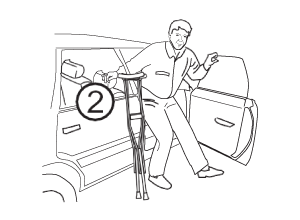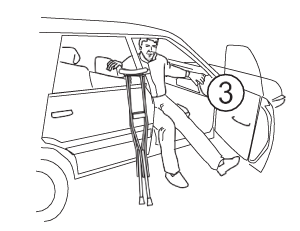Your PT will show you how to walk with the correct walking aid to keep you safe, and teach you the exercises that are part of your recovery. Let your nurse or PT know if you’re worried about falling.
Use a walker or cane to protect your hip at
all times until your healthcare team says you don’t need to use it anymore.
If you’re
using a walker after hip surgery your doctor or physiotherapist will tell you when you can stop using it.
If you’re
using a cane after hip surgery your doctor or physiotherapist will tell you when you can stop using it.
If
crutches are an option for you, your physiotherapist will teach you how to use them.
Your OT will show you how to manage your ADLs while you’re in the hospital. You’ll get information about resources and equipment that will help you manage at home after surgery. It’s important that you have this equipment before you go home. Your healthcare team will help you plan for your discharge home.
The OT will assess how independent you are in 3 areas:
- your exercise program
- your mobility
- how well you can manage at home
While you’re recovering, you may find that you tire very easily. Feeling tired is normal and will go away over time.
Using the Toilet
Make sure the toilet paper is within easy reach especially if you’re using a raised toilet seat and toilet arm.
- Back up until you feel the toilet touch the back of your legs.
- Move your operated leg slightly forward.
- Bend both knees and lower yourself slowly on to the toilet seat using the countertop, sink, or toilet armrests for support.
To stand up follow these steps in reverse order. Always push up with your hands from where you’re seated. Remember to raise yourself from the toilet using a solid surface or bar instead of with your walker.
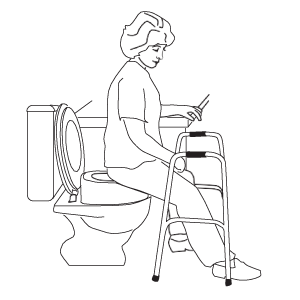
Getting In and Out of Bed
You may or may not be able to get into bed on the same side as you usually did before. Stay away from low beds, very high beds, or soft mattresses. When you’re lying on your side, support your operated leg with pillows between your legs.
- Back up until you feel the bed behind your knees. Move your operated leg slightly forward.
- While holding onto the crutches with one hand, reach behind with the opposite hand to find the bed surface. If you’re using a walker, reach for the bed with both hands.
- Sit and slide your buttocks backward on the bed.
- Pivot on your buttocks as you lift your legs onto the bed. You can support the operated leg with your stronger leg or a leg strap if you’re having trouble.
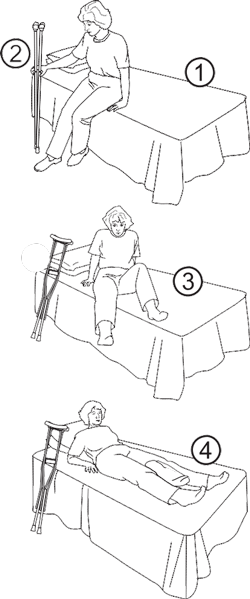
Getting In and Out of Bed
Reverse the steps to get out of bed.
Note: You may find it more comfortable to use 1 or 2 pillows to keep your legs apart when lying in bed even when lying on your back.
Bathing
At first, have a sponge bath or shower from a sitting position at the sink, in the tub, or in a walk-in shower. Sit during your shower for your safety.
You may find it helps to have a wooden chair or sturdy stool in the bathroom for when you come out of the bathtub or shower. That way, you can take your time drying yourself.
Your OT may suggest you use some or all the equipment below:
- an adjustable height bath or shower seat
- detachable tub grab bar
- other safety rails
- long-handled bath sponge
- hand-held shower head
Transfer Techniques: Walk-In Shower and Bathtub
For safety reasons, sliding doors in the tub may have to be taken out for now and replaced with a shower curtain. Your OT will let you know what’s best for you.
Make sure you take away any scatter rugs and place a non-slip mat in the bathtub.
Walk-In Shower
- Walk to the lip of the shower. Turn so that you’re facing away from the shower stall.
- Leaving 1 hand holding the middle of the horizontal bar on the walker, use the other hand to reach for the back of the chair.
- Move your operated leg forward.
- Sit down on the chair.
- Lift your legs over the lip of the shower stall, then turn to sit facing the faucet.
Bathtub
- Stand in front of the tub, turn, then back up slightly with your walking aid so that you can feel the tub against the back of your legs.
- Hold onto the tub rail for support. With your other hand, reach back for the bath seat.
- Move your operated leg forward slightly and lower your buttocks on to the bath seat.
- Turn on your buttocks, lifting your legs one at a time up and over the side of the tub.
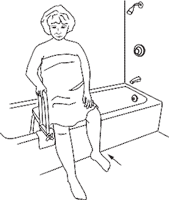
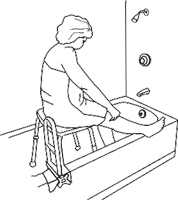
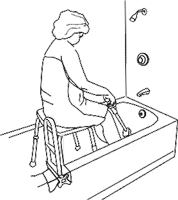
Follow these steps in reverse order to get out of the tub or shower.
Getting Dressed
- Your OT will recommend adaptive equipment to help you dress yourself like a reacher or long-handled shoehorn.
- Your OT will show you how to dress to protect your operated hip.
- Choose loose-fitting clothes.
- Wear socks with low-heeled shoes, like running shoes, for firm support.
- Remember: dress the operated leg first and undress it last.
Housekeeping and Cooking
Some activities at home will be hard to do. You may need help from family and friends with cooking, grocery shopping, vacuuming, laundry, and driving.
- If you aren’t able to have someone help you when you first get home, talk to your OT about ways and resources that can help.
- If your family or friends want to rearrange your furniture to try to make things easier for you, let them know you want to be involved.
Getting In and Out of a Car
Try not to travel in small cars, low bucket seats, and vehicles that you have to step up into. Sit in the front seat whenever possible. Your therapist will tell you how to do car transfers depending on the car.
Have your driver park the car about 1 metre (3 feet) away from the curb. Have the driver slide the passenger seat back as far as it will go.
You may find that a large plastic bag on the seat makes sliding in and out of the car easier.
- Back up with your walking aid until you can feel the edge of the car against the back of your legs.
- Hold the back of the seat and the car frame for support. Slide your operated leg forward slightly, bend both your knees, and lower yourself onto the car seat. Watch your head!
- Slide your buttocks toward the middle of the car. Turn on your buttocks, lifting your legs one at a time into the car.
Follow these steps in reverse order to get out of the car.
